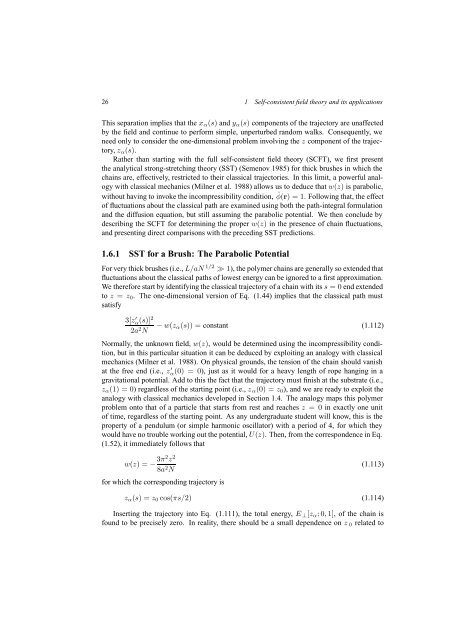Self-Consistent Field Theory and Its Applications by M. W. Matsen
Self-Consistent Field Theory and Its Applications by M. W. Matsen
Self-Consistent Field Theory and Its Applications by M. W. Matsen
Create successful ePaper yourself
Turn your PDF publications into a flip-book with our unique Google optimized e-Paper software.
26 1 <strong>Self</strong>-consistent field theory <strong>and</strong> its applications<br />
This separation implies that the x α (s) <strong>and</strong> y α (s) components of the trajectory are unaffected<br />
<strong>by</strong> the field <strong>and</strong> continue to perform simple, unperturbed r<strong>and</strong>om walks. Consequently, we<br />
need only to consider the one-dimensional problem involving the z component of the trajectory,<br />
z α (s).<br />
Rather than starting with the full self-consistent field theory (SCFT), we first present<br />
the analytical strong-stretching theory (SST) (Semenov 1985) for thick brushes in which the<br />
chains are, effectively, restricted to their classical trajectories. In this limit, a powerful analogy<br />
with classical mechanics (Milner et al. 1988) allows us to deduce that w(z) is parabolic,<br />
without having to invoke the incompressibility condition, ˆφ(r) =1. Following that, the effect<br />
of fluctuations about the classical path are examined using both the path-integral formulation<br />
<strong>and</strong> the diffusion equation, but still assuming the parabolic potential. We then conclude <strong>by</strong><br />
describing the SCFT for determining the proper w(z) in the presence of chain fluctuations,<br />
<strong>and</strong> presenting direct comparisons with the preceding SST predictions.<br />
1.6.1 SST for a Brush: The Parabolic Potential<br />
For very thick brushes (i.e., L/aN 1/2 ≫ 1), the polymer chains are generally so extended that<br />
fluctuations about the classical paths of lowest energy can be ignored to a first approximation.<br />
We therefore start <strong>by</strong> identifying the classical trajectory of a chain with its s =0end extended<br />
to z = z 0 . The one-dimensional version of Eq. (1.44) implies that the classical path must<br />
satisfy<br />
3[z α ′ (s)]2<br />
2a 2 N − w(z α(s)) = constant (1.112)<br />
Normally, the unknown field, w(z), would be determined using the incompressibility condition,<br />
but in this particular situation it can be deduced <strong>by</strong> exploiting an analogy with classical<br />
mechanics (Milner et al. 1988). On physical grounds, the tension of the chain should vanish<br />
at the free end (i.e., z α ′ (0) = 0), just as it would for a heavy length of rope hanging in a<br />
gravitational potential. Add to this the fact that the trajectory must finish at the substrate (i.e.,<br />
z α (1) = 0) regardless of the starting point (i.e., z α (0) = z 0 ), <strong>and</strong> we are ready to exploit the<br />
analogy with classical mechanics developed in Section 1.4. The analogy maps this polymer<br />
problem onto that of a particle that starts from rest <strong>and</strong> reaches z =0in exactly one unit<br />
of time, regardless of the starting point. As any undergraduate student will know, this is the<br />
property of a pendulum (or simple harmonic oscillator) with a period of 4, for which they<br />
would have no trouble working out the potential, U(z). Then, from the correspondence in Eq.<br />
(1.52), it immediately follows that<br />
w(z) =− 3π2 z 2<br />
8a 2 N<br />
for which the corresponding trajectory is<br />
(1.113)<br />
z α (s) =z 0 cos(πs/2) (1.114)<br />
Inserting the trajectory into Eq. (1.111), the total energy, E ⊥ [z α ;0, 1], of the chain is<br />
found to be precisely zero. In reality, there should be a small dependence on z 0 related to
















